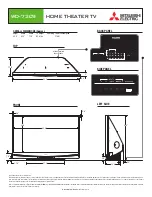
13
4.6
RETRIEVAL OPERATION:
Figure 10 illustrates operation of the Integral Rescue Hand Crank on the Sealed-Blok Retrieval
SRL-R. Do not attempt to operate Retrieval with the lifeline fully retracted. To activate Retrieval mode and use the Rescue
Hand Crank:
1. Loosen the Locking Thumb Screw to release the Crank Arm.
2.
Rotate the Retrieval Handle up from the SRL Body 90°.
3.
Pull and hold the Shift Knob in the unlocked position.
4.
Push the Crank Arm in and release the Shift Knob to engage. If needed, rotate the Crank Arm clockwise to help
engage the gear.
5.
Raise and lower the Lifeline as illustrated in Figure 10:
A.
To Raise: Rotate the Crank Arm clockwise.
B. To Lower: Rotate the Crank Arm counterclockwise. After fall arrest; crank the Crank Arm clockwise slightly first
to release the Fall Arrest Brake, then crank the Crank Arm counterclockwise.
;
The Integral Rescue Hand Crank on 3-Way Emergency Retrieval SRL-R models is for rescue purposes only and
should not be used for work positioning or material lifting/lowering.
;
DBI-SALA SRL-Rs do not incorporate an Overload Clutch to limit the force exerted on the drive components and
attached person. Avoid line slack while in Retrieval mode. Also, monitor the individual during retrieval to ensure they
are not subjected to excessive force from continued lifting after entanglement on an obstruction.
;
A minimum load of 75 lbs (33.9 kg) is required to lower or pay out the Lifeline. A force of 30 lbs (0.13 kN) is
required to operate the Retrieval system when loaded to capacity.
;
Stop cranking when the Lifeline is fully extended or retracted. Continued cranking can damage components.
4.7
RETRIEVAL DISENGAGEMENT:
To disengage Retrieval mode:
;
When Retrieval mode is disengaged, any extended Lifeline will retract into the SRL. To avoid possible injury, retract
the Lifeline prior to disengagement or hold onto the Lifeline.
1. Remove any load from the Lifeline.
2. Pull and hold the Shift Knob in the unlocked position.
3.
Pull the Crank Arm out to disengage and then release the Shift Knob.
4.
Pull out and rotate the Retrieval Handle down toward the SRL Body to stowed position.
5.0 Inspection
5.1
RFID TAG:
The Self-Retracting Device includes a Radio Frequency Identification (RFID) tag (see Figure 11). The RFID tag
can be used in conjunction with the handheld reading device and web based portal to simplify inspection and inventory
control and provide records for your fall protection equipment. For details, contact a 3M Customer Service representative
(see back cover). Follow the instructions provided with your handheld reader, or on the web portal, to transfer your data
to your web log.
5.2
INSPECTION FREQUENCY:
The Sealed-Blok Self-Retracting Device must be inspected at the intervals defined in
Section
2 (Inspection Frequency)
. Inspection procedures are described in the
“Inspection & Maintenance Log” (Table 3)
.
;
Extreme working conditions (harsh environments, prolonged use, etc.) may require increasing the frequency of
inspections.
5.3
UNSAFE OR DEFECTIVE CONDITIONS:
If inspection reveals an unsafe defective condition, remove the
Self-Retracting Device from service immediately, mark as “UNUSABLE”, and perform a Competent Person inspection to
determine service options.
5.4
PRODUCT LIFE:
The functional life of DBI-SALA Self-Retracting Devices is determined by work conditions and
maintenance. As long as the product passes inspection criteria, it may remain in service.










































